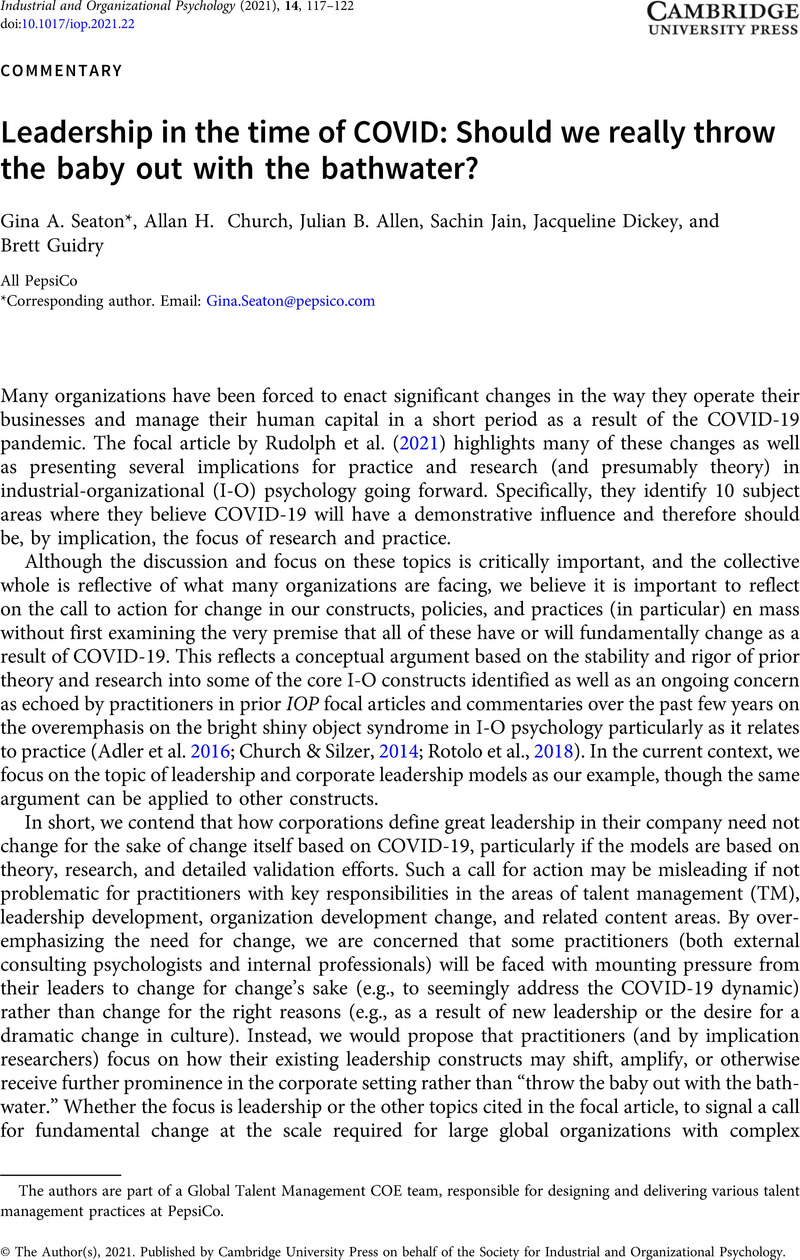No CrossRef data available.
Article contents
Leadership in the time of COVID: Should we really throw the baby out with the bathwater?
Published online by Cambridge University Press: 24 May 2021
Abstract
An abstract is not available for this content so a preview has been provided. Please use the Get access link above for information on how to access this content.

- Type
- Commentaries
- Information
- Industrial and Organizational Psychology , Volume 14 , Special Issue 1-2: Special Pandemic Issue , June 2021 , pp. 117 - 122
- Copyright
- © The Author(s), 2021. Published by Cambridge University Press on behalf of the Society for Industrial and Organizational Psychology.
Footnotes
The authors are part of a Global Talent Management COE team, responsible for designing and delivering various talent management practices at PepsiCo.
References
Adler, S., Campion, M., Colquitt, A., Grubb, A., Murphy, K., Ollander-Krane, R., & Pulakos, E. (2016). Getting rid of performance ratings: Genius or folly? A debate. Industrial and Organizational Psychology: Perspectives on Science and Practice, 9(2), 219–252. https://doi.org/10.1017/iop.2015.106
CrossRefGoogle Scholar
Church, A. H., Dawson, L. M., Barden, K. L., Fleck, C. R., Rotolo, C. T., & Tuller, M. D. (2018). Enhancing 360 feedback for individual assessment and organization development: Methods and lessons from the field. In Noumair, D. A. & Shani, A. B. (Eds.), Research in organizational change and development (Vol. 26, pp. 47–97). Emerald Publishing.CrossRefGoogle Scholar
Church, A., & Ezama, S. (2020, April). PepsiCo’s formula for leadership potential. TD Magazine, 34–39.Google Scholar
Church, A. H., Rotolo, C. T., Shull, A. C., & Tuller, M. D. (2014). Inclusive organization development: An integration of two disciplines. In Ferdman, B. M. & Deane, B. (Eds.). Diversity at work: The practice of inclusion (pp. 260–295). Jossey-Bass.CrossRefGoogle Scholar
Church, A. H., & Silzer, R. F. (2014). Going behind the corporate curtain with a BluePrint for Leadership Potential: An integrated framework for identifying high-potential talent. People & Strategy, 36(4), 51–58.Google Scholar
Church, A. H., & Silzer, R. (2016). Are we on the same wavelength? Four steps for moving from talent signals to valid talent management applications. Industrial and Organizational Psychology: Perspectives on Science and Practice, 9(3), 645–654.CrossRefGoogle Scholar
Dunnette, M. D. (1990). Blending the science and practice of industrial and organizational psychology: Where are we and where are we going? In Dunnette, M. D., Triandis, H. C., & Hough, L. M. (Eds.), Handbook of industrial and organizational psychology (Vol. 2, p. 1–38). Consulting Psychologists Press.Google Scholar
Katz, D., & Kahn, R. L. (1978) The social psychology of organizations (2nd ed.). Wiley.Google Scholar
Nooyi, I., & Govindarajan, V. (2020, March–April). Becoming a better corporate citizen. Harvard Business Review. https://hbr.org/2020/03/becoming-a-better-corporate-citizen
Google Scholar
Pahalad, C., & Hamel, G. (1990, May–June). The core competency of the corporation. Harvard Business Review, 79–91.Google Scholar
Rotolo, C. T., Church, A. H., Adler, S., Smither, J. W., Colquitt, A. L., Shull, A. C., Paul, K. B., & Foster, G. (2018). Putting an end to bad talent management: A call to action for the field of industrial and organizational psychology. Industrial and Organizational Psychology: Perspectives on Science and Practice, 11(2), 176–219.CrossRefGoogle Scholar
Rudolph, C., Allan, B., Clark, M., Hertel, G., Hirschi, A., Kunze, F., Shockley, K., Shoss, M., Sonnentag, S., & Zacher, H. (2021). Pandemics: Implications for research and practice in industrial and organizational psychology. Industrial and Organizational Psychology: Perspectives on Science and Practice, 14(1), 1–35.Google Scholar
Shippmann, J. S., Ash, R. A., Battista, M., Carr, L., Eyde, L. D., Hesketh, B., Kehoe, J., Pearlman, K., Prien, E. P., & Sanchez, J. I. (2000). The practice of competency modeling. Personnel Psychology, 53(3), 703–740.CrossRefGoogle Scholar
Silzer, R., & Church, A. H. (2009). The pearls and perils of identifying potential. Industrial and Organizational Psychology: Perspectives on Science and Practice, 2(4), 377–412.CrossRefGoogle Scholar
Silzer, R. & Church, A. H. (2010). Identifying and assessing high potential talent: Current organizational practices. In Silzer, R. & Dowell, B. E. (Eds.), Strategy-driven talent management: A leadership imperative (pp. 213–279). Jossey-Bass.Google Scholar
Silzer, R., Church, A. H., Rotolo, C. T., & Scott, J. C. (2016). I-O practice in action: Solving the leadership potential identification challenge in organizations. Industrial and Organizational Psychology: Perspectives on Science and Practice, 9(4), 814–830.CrossRefGoogle Scholar
Thomas, D. A., & Creary, S. J. (2009). Meeting the diversity challenge at PepsiCo: The Steve Reinemund Era (Case: 9-410-024). Harvard Business School Publishing.Google Scholar
Zaccaro, S. J., Green, J. P., Dubrow, S., & Kolze, M. (2018). Leader individual differences, situational parameters, and leadership outcomes: A comprehensive review and integration. Leadership Quarterly, 29, 2–43.CrossRefGoogle Scholar




